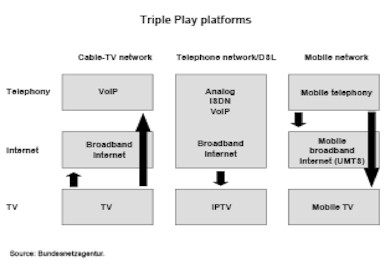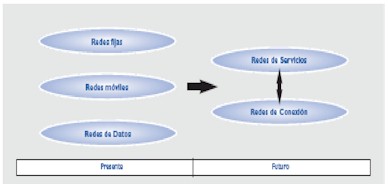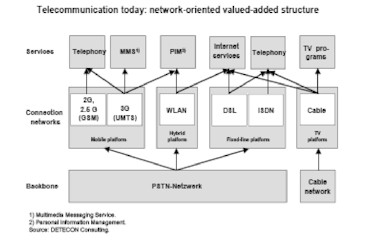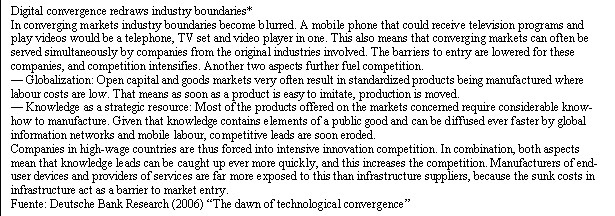|
Types of convergence
Two types of convergence
environments are generally recognized. Convergence
in platforms is the most widespread type and permits
consumers to access multiple services from a single
platform. For example, cable television networks
permit the provision of internet and telephony
services in addition to their original business,
which is the distribution of audiovisual signals.
The integration of services in telecommunication
networks also permits the distribution of video, in
addition to traditional telephony and internet
services. Mobile networks offer similar
possibilities (see figure below).
Note that this movement toward
business areas other than those operators originally
adopted did not stem from regulatory changes but is
rather a consequence of a technological shock.

Thus, as mentioned, we are
advancing toward a future scenario of ¨everything on
IP¨ type networks, in which the same infrastructures
will serve to transport all types of information,
regardless of their origin (voice, data, video,
etc.).

Source. Observatorio de
perspectiva tecnológica industrial. Spain
In a second recognized
environment, this fusion of services is observed,
which is known as equipment convergence. It permits
users to access different services from the same
device or terminal even if they are sent by
different platforms (a mobile telephone which
broadcasts radio, for example). Given the rapid
technological evolution in this field, in the short
and medium term, it is likely that an overlapping of
functions will occur in the next generation devices,
in which all or several services offered
individually by each operator will converge. In
addition, the need to access and transmit increasing
volumes of information in contexts of mobility, in a
continuous manner between different types of
networks and in a fully transparent way for the
user, demands the availability of mobile terminals
that can operate with a variety of technological
standards and platforms (Bluetooth, UMTS, Wi-Fi,
WiMAX, DVB-H, etc.).

Source. Observatorio de
perspectiva tecnológica industrial. Spain
Current technological trends
permitting the commercial integration of
communications, information and entertainment (or
media) services are the result of two stages or
¨waves¨ of innovation.
An initial technological wave has
to do with digitization, the subsequent use of
computerization and the adoption of a language (or
protocol) of interaction as the IP standard. In
effect, digitization, when it ¨translates¨ all
contents to a single format, regardless of their
origin, permits operators to adapt distribution
media to previously separate services, developing
synergies throughout the value chain of the industry
given that the product is essentially bytes of
information.
Moreover, computerization is the
logical consequence of digitization given that it is
the ideal medium for processing content. In
addition, its use plays a pivotal role by permitting
a much more efficient administration of networks
given its increased capacity to process information
by time unit as compared with analog networks.
Finally, technology packets
facilitate the use of digitalized resources and
computerized networks by adopting an administrative
system for shared information flows, permitting
interoperability.
This first wave is definitely one
of inventions or technological developments. The
second wave is that of their mass application, in
other words, transforming inventions into
innovations, in addition to adapting other physical
distribution media (especially wireless) to that
end.
The spread of IP protocol as a
standard in practically all infrastructures and
services permitted the de facto separation of the
transmission platform and the platform of services
and applications. This event is known as the
decentralization of ¨intelligence¨ (see figure).

For example, traditional
telephony was a highly centralized technology in the
sense that much of the functions and ¨intelligence¨
of the network was concentrated in stations and,
consequently, usually administered by the network
operator. Terminal equipment with limited functions
was applied to this network. By contrast, in an IP
network, no entity has complete control over the
functions of the network and the ¨intelligence¨ is
usually designed outside the network and applied at
its edges, whether in the equipment terminals
themselves or in alternative solutions. There no
longer appears to be a network ¨dedicated¨ to a
service but rather networks that act like
multi-service platforms. Some of these networks may
be provided by independent operators.
Currently, the trend is toward
building networks based on packet transmission in
accordance with IP protocol, regardless of the type
of signals transmitted, enabling access to the ¨last
mile¨ through different technologies. This takes
maximum advantage of available resources and at the
same time reduces exploitation costs.
International experience
indicates that the nature of the telecommunications
sector is already integrated with the media
The lack of identification among
services and networks led some authors to eventually
refer to network models in ¨layers.¨ In the
traditional model, the telecommunication networks
were vertically integrated and usually operated by
the operator. The configuration of a network
consisted of layers or levels, which led it to be
known as the Layered Network Model. Traditionally,
the value chain of the sector was organized in
layers that were practically indissolubly linked.
These existed in an environment of co-existing
networks (mobile, fixed).

Interfaces between layers were
technically standardized and commercially agreed
upon by services. For example, a service operator
contracted in the transport ¨layer¨ could rent
optical fiber to different providers of that
infrastructure service, even to its own vertically
integrated competitors (that is, they had an
available network and provided final services).
In the current technological
scenario, operators of some final services do not
need that contracting process to provide services
because they can do so based on the IP network in a
world where the ¨layers¨ are much more disperse than
previously. This architecture allows service
innovation to be a characteristic element, much more
so than in traditional models.
Therefore, the change toward an
IP environment tends to replace the vertically
integrated change with an open horizontally
integrated chain, although also with some degree of
vertical integration (see figure below). An ¨open¨
network refers only to the capacity to provide
multiple services in a common platform, in other
words, without the absolute identification of the
type of service or type of network.

As a result of this process, the
structure of ICT industries and the boundaries
between activities of the different agents involved
(for example, telecommunication and radio
broadcasting operators, suppliers of technology and
content generators, among others) will have to be
blurred once again in order to create alliances or
new forms of competition between them, by attempting
to cover increasingly large parcels of the value
chain.
These explanations on the erasing
of boundaries between ICTs are based on supply
issues, that is, technologies. Nevertheless, demand
equally accompanies the process.
The supply of multiple play
services is growing rapidly around the world,
eloquently showing that users value these offers and
that their adoption favors the interests of these
users. A preliminary interpretation is that this
change merely reflects the fact that users also
perceive that the distinctions between communication
and media services do not justify their separate
delivery when technology and commercial practices
permit their integration.
The growth of commercial triple
play services in developed countries confirms this;
in other words, this business model has been
accepted in regulatory terms. According to the ITU,
there were nearly 90 commercial services by late
2006 (see figure). Examples include France and the
United States, with at least five competitive
commercial services apiece; and the United Kingdom,
Japan and Italy, with three each. Spain has two
competitive services.

Sources: ITU Strategy and Policy
Unit. NGN and N-Play Services: Strategy and Policy
Considerations.
Since there is technological
integration between previously separate platforms
and adoption from the demand of “multiple play”
offers, there are fewer possibilities to question
whether the correct definition of industry is
different from those prevailing without such
integrating trends.
Different sources confirm this
trend to admit that the boundaries between
communication and media industries become
economically unjustified and, consequently,
regulatory. For example, in a recent capital market
report, the Deutsche Bank underscores that
traditional distinctions are blurred in a converging
market and that this erosion of barriers promotes
competition (see table).

In the same sense, NERA (2006)
indicates: “As convergence continues to blur, and
even erase, the boundaries between several
technologically distinct sectors, sector-specific
regulations (such as those that emerged from the
tradition of public utility regulation and were
designed for natural monopoly environments) may
become, at best, anachronistic and, at worst,
irrelevant.”
A new industry, new relevant
markets
Thus, given the new definition of
industry, the prevailing competitive context must be
different from those in force a few years ago
because the possibilities for competition based on
new technologies change the profile of market
participants and allow the entry of other new ones.
As a result of these changes, we may say that
convergence drives a different definition of
relevant market.
The concept of relevant market
defines the competitive and rivalry context
prevailing in an industry. In this issue of
definition of market scopes or limits, there are in
turn concepts that should be previously taken into
consideration.
The definition of product: What
is the product or service traded through ICTs? The
definition of a product has a strong supply
component because it is the supply which defines
production conditions, the prevailing technology and
its distribution media. As we explained, convergence
makes a strong dissociation between the final
service destination (or how it will be consumed) and
the way it is physically delivered due to the new
configuration in “layers”. With digitization, all
contents produced and distributed through convergent
networks have a common format. For that purpose,
from the supply standpoint, the distinction is
inappropriate. As a result of the aforementioned,
sometimes it is mentioned that contents are
“information assets” not differentiable in their
physical provision and only distinguishable in their
uses or in the type of information they carry. In
one first approach, this would indicate that, based
on the supply characteristics, we should talk about
an industry of information assets and a unified
market.
Obviously, the information
content is absolutely relevant and distinguishable
from the demand (for example, one byte of video is
different from one byte of voice). That is,
addressing the discussion from the consumer’s
standpoint seems to lead to an opposite conclusion
to that of the previous paragraph: products are
distinguishable, despite the technological
production and distribution mode, and not
replaceable, leading in principle to different
definitions of relevant markets. In effect, users
demand “information assets” for specific purposes:
communications, entertainment, etc., which meet
different demands and, therefore, from that point of
view, they should belong to or be categorized into
different or diverging relevant markets.
Nevertheless, there is one
characteristic of ICT industries that attenuates
this divergence. From the moment different platforms
can provide all types of “information assets” in a
competitive manner under aggregated commercial forms
or “bundles” and the demand adopts this type of
provision, the definition of market tends to be
convergent again.
The way to resolve this apparent
contradiction is that, as a matter of fact, the
aggregated commercial offer (for example, telephony,
Internet and television) really creates a new
relevant market and not necessarily replaceable to
that of the isolated offer (for example, telephony).
That is, there are two markets at once and which of
them will be the “relevant” one will depend on the
competitive conditions that may be analyzed and,
basically, the adoption or not stemming from the
demand of joint offers.
In summary, although the
different types of contents provided are not
replaceable with each other from the demand
standpoint, in order to integrate them with a single
definition of market, their integration from the
offer and the growing acceptance of bundles as a
practice suggest that they participate in the same
relevant market or they create a supplementary
market to those where the single offer prevails.
Even in the eventual cases in
which the standard -or the jurisprudence- would
adopt a “disaggregated” vision (for example,
defining paid television, excluding
telecommunication services, as a relevant market),
convergence restrains the definition of relevant
market from the offer replacement standpoint. This
concept makes reference, in the short and medium
term, to the capacity of new operators to enter the
market, that is, it relates to the potential
competition. Since it is possible to distribute
contents that will replace pre-existing contents (in
this example, audiovisual contents) through
alternative media already installed, it is
reasonable to deduce that those media are a
replacing threat and, therefore, given their
probability of entry, are part of the same relevant
market.
That is, jurisprudence can assume
a disaggregated version of relevant markets but
cannot avoid that suppliers from other activities
can be able to participate in the market in networks
that were being used in other activities.
This issue on relevant and
replacement markets, from the offer standpoint, in
industries such as ICTs, has been addressed a long
time ago by the European Commission, which is the
supra-national competition organization of the
European Union. One of the most important
conclusions reached through a report prepared by
consulting firm European Economics is that
technology convergence allows creating a new joint
commercial offer, which modifies the nature of the
product itself thereby creating a new relevant
market complementary or coexisting in principle with
those already defined. If the demand trend is the
migration to aggregated offers and the abandonment
of individual offers, then the weight relating to
this new market grows despite those where these
disaggregated offers persist.
When commercial offers provide
advantages to users, the process to create a new
relevant market, which was already “technologically
possible” from the offer, is inevitable. That is
precisely the new definition explicitly adopted by
some regulatory agencies (For example, Europe) or,
as a matter of fact, by others (the United States)
when accepting the provision of those offers by
companies stemming from previously different
activities.
We can focus this issue of
relevant markets from an “organizational”
perspective, in which it is shown that the
technological change opens doors to modify the
original activities of companies and to create
capacities different from those that gave lieu to
such organizations. This perspective suggests that
communication companies mutate to companies that
provide “information assets” and also to those
companies that originate in the industry of the
media that include communication services
(particularly Internet), thus becoming companies
that provide “information assets”. The table below
shows the “core competencies” or original
competencies of each distribution media.
Original competencies by
technology

According to the new
technological conditions, each operator “moves
forward” on activities that do not constitute their
core competition, thereby creating intermodal
competition and, therefore, the weakening of
barriers between activities and pure definitions of
market.
The unavoidable consequence of
these organizational changes is the redefinition of
competitors in each activity, which naturally means
that the definition of relevant market has mutated
to a broader version, even independently from the
exact regulatory definitions each country has.
Our region is of course not apart
from this trend. Currently, there are cable TV
companies that provide telecommunication services,
such as traditional telephony, IP telephony and
Internet. Moreover, energy-related companies are
evaluating using their networks to provide services
relating to these new definitions of market.
Original and acquired
competencies by technology

In short, the communication and media market has
indefectibly started a road towards service
integration and where rivalry will intensely grow as
regulatory standards adapt to this change. This will
allow users to freely choose between operators,
platforms and services.
We say that this road towards integration has
already begun, particularly because there are
already “double play” commercial offers between
Internet services and audiovisual signals such as
those provided by cable operators.
In this sense, it is possible to say that the
Internet access provision market already shows full
convergence because the sector legislation is open
to competition, not imposing barriers to operators
stemming from other activities, unlike the
broadcasting market where its specific regulation
does establish barriers.
Thus, the trend towards integration of services
by platforms is already a reality and there are
still regulatory barriers that hinder a final
implementation by telecommunication providers.
Note of the Editor: in the
next number of info @ CITEL we will publish the next
part of this report.
Ignacio Luis Bergallo
Manager of International Regulations
Telefónica de Argentina
|










